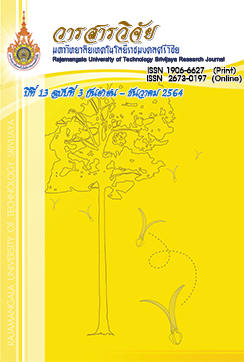Chemical and Physical Properties of Cold-pressed Sangyod Rice Bran Oil and Its Application in Sangyod Rice Cookies
Keywords:
cookies, rice bran oil, cold-pressed, Sangyod rice, phytochemicalAbstract
The objectives of this research were to examine the quality of cold-pressed Sangyod rice bran oil (CSRBO) and the application of CSRBO in Sangyod rice cookies. The data showed that hexane extraction had higher extraction yield and chemical properties than that of cold pressing method. CSRBO had lower values in acid, peroxide and free fatty acid than that of hexane extracted Sangyod rice bran oil (SRBO) (p<0.05). Furthermore, CSRBO had higher monounsaturated fatty acid, vitamin and phytochemical contents and element contents than that of hexane extracted SRBO (p<0.05). The effect of CSRBO replacing margarine on the qualities of Sangyod rice cookies was studied. CSRBO were substituted for 0% 5% 10% 15% and 20% of margarine in Sangyod rice cookies. CSRBO had no impact on fat and ash contents of cookies, but cookies containing CSRBO had higher moisture content than that of the control sample (p<0.05). Increasing CSRBO up to 10% caused a growth in product color, hardness, fracturability, spread ratio and bulk density (p<0.05). However, substitution with 5% CSRBO did not affect the hardness of cookies (p≥0.05). The results showed that the sensory acceptance of cookies with a rise of CSRBO up to 10% reduced the sensory score of cookies. However, substitution with 5% CSRBO was not significantly different from the control unit (p≥0.05).
References
AACC. 2000. Approved Method of the American Association of Cereal Chemists. 8thed. The American Association of Chemists, Minnesota.
AOAC. 1999. Official Method of Analysis. 16thed. Association of Official Analytical Chemists., Washington DC.
AOAC. 2000. Official methods of analysis. 17thed. Association of Official Analytical Chemists, Washington DC.
Fennema, O.R. 1996. Food chemistry. 3rd ed. Marcel Dekker, New York.
Godber, J.S. 2008. Rice bran oil, pp. 377-408. In Moreau, R.A. and Kamal-Elddin, A., eds. Gourmet and health-promoting specialty oils. AOCS Press, Illinois.
Jia, Z., Tang, M. and Wu, J. 1998. The determination of flavonoid contents in mulberry and their scavenging effects on superoxides radicals. Food Chemistry 64: 555-559.
Juliano, B.O. 1985. Rice Chemistry and technology. The American Association of Cereal Chemist, St. Palu.
Lai, P., Li, K.Y., Lu, S. and Chen, H.H. 2009. Phytochemicals and antioxidant properties of solvent extracts from Japonica rice bran. Food Chemistry 117: 538-544.
Mezouari, S., Eichner, K., Kochharb, S.P. and Schwarz, K. 2006. Effect of the full refining process on rice bran oil composition and its heat stability. European Journal of Lipid Science and Technology 108: 193-199.
Mezouari, M. and Eichner, K. 2007. Comparative study on the stability of crude and refined rice bran oil during long-term storage at room temperature. European Journal of Lipid Science and Technology 109: 198-205.
Moreau, R.A. and Kamal-Elddin, A. 2008. Introduction, pp. 1-32. In Moreau, R.A. and Kamal-Elddin, A., eds. Gourmet and health-promoting specialty oils. AOCS Press, Illinois.
Narayana, N., Kaimai, B., Vali, S.R., Surya, B.V., Rao, K., Chakrabarti, P.P., Vijayalakshmi, P., Kale, V., Narayana, K., Rani, P., Rajamma, O., Bhaska, P.S. and Roa, T.C. 2002. Origin of problems encountered in rice bran oil processing. European Journal of Lipid Science and Technology 104: 203-211.
Pareyt, B., Wilderjans, E., Goesaert, H., Brijs, K. and Delcour, J.A. 2008. The role of gluten in a sugar-snap cookie system: a model approach based on gluten-starch blends. Journal of Cereal Science 48(3): 863-869.
Proctor, A. and Bowen, D.J. 1996. Ambient-temperature extraction of rice bran oil with hexane and isopropanol. Journal of the American Oil Chemists Society 73: 811-813.
Ramezanzadeh, F.M., Rao, R.M., Prinyawiwatkul, W., Marshall, W.E. and Windhauser, M. 2000. Effects of microwave heat, packaging, and storage temperature on fatty acid and proximate compositions in rice bran. Journal of Agricultural and Food Chemistry 48: 464-467.
Steel, R.G.D. and Torrie, J.H. 1980. Principles and procedures of statistics: A biometrical approach. 2nded. McGraw-Hill, New York.
Thanonkaew, A. and Wongyai, S. 2011. Process development for quality improvement of cold-pressed rice bran oil. Area Based Development Research Journal 3(5): 97-113. (in Thai)
Thanonkaew, A., Wongyai, S., McClements, D.J. and Decker, E.A. 2012. Effect of stabilization of rice bran by domestic heating on mechanical extraction yield, quality, and antioxidant properties of cold-pressed rice bran oil (Oryza saltiva L.). LWT - Food Science and Technology 48: 231-236.
Zigoneanu, I.G., Williams, L., Xu, Z. and Sabliov, C.M. 2008. Determination of antioxidant components in rice bran oil extracted by microwave-assisted method. Bioresource Technology 99: 4910-4918.
Downloads
Published
How to Cite
Issue
Section
License
The content and information in the article published in Journal of Rajamangala University of Technology Srivijaya It is the opinion and responsibility of the author of the article. The editorial journals do not need to agree. Or share any responsibility.







